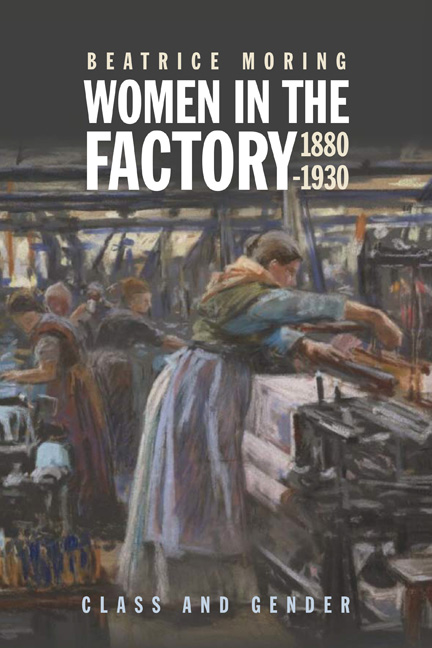Book contents
- Frontmatter
- Contents
- List of Illustrations
- Introduction – Why Women in the Factory?
- 1 Gender And Class – Male Unions, Political Movements and the Female Vote
- 2 Women in Industry: Work, Sectors, Age and Marital Status
- 3 Women, Earnings and the Household – Why the Factory?
- 4 Accidents, Compensation, Laws and Inspection
- 5 Middle Class Girls, Education and Entry into the Civil Service
- 6 The Female Factory Inspectors – How, Why and Who
- 7 Factory Inspection Activity
- 8 Class, Gender and Communication
- Conclusion
- Appendix 1 The Right for Women to Vote in National Elections
- Appendix 2 Women in the Workforce
- Appendix 3 Women, Work, Earnings and Family
- Appendix 4 Accidents, Workplace Acts and Regulations
- Appendix 5 Education
- Appendix 6 Female Inspectors
- Appendix 7 Inspectors, Activity
- Appendix 8 The Female Inspectors and Society
- Bibliography
- Index
Introduction – Why Women in the Factory?
Published online by Cambridge University Press: 09 May 2024
- Frontmatter
- Contents
- List of Illustrations
- Introduction – Why Women in the Factory?
- 1 Gender And Class – Male Unions, Political Movements and the Female Vote
- 2 Women in Industry: Work, Sectors, Age and Marital Status
- 3 Women, Earnings and the Household – Why the Factory?
- 4 Accidents, Compensation, Laws and Inspection
- 5 Middle Class Girls, Education and Entry into the Civil Service
- 6 The Female Factory Inspectors – How, Why and Who
- 7 Factory Inspection Activity
- 8 Class, Gender and Communication
- Conclusion
- Appendix 1 The Right for Women to Vote in National Elections
- Appendix 2 Women in the Workforce
- Appendix 3 Women, Work, Earnings and Family
- Appendix 4 Accidents, Workplace Acts and Regulations
- Appendix 5 Education
- Appendix 6 Female Inspectors
- Appendix 7 Inspectors, Activity
- Appendix 8 The Female Inspectors and Society
- Bibliography
- Index
Summary
What women wanted
During the first week of July, 1900, the First General Meeting of the Unions of Working Women was held in Helsinki. Representatives of 21 women's unions met in the premises of The Worker's Organisation of Helsinki, where the women's section had set up a coffee breakfast for the delegates at 8.00 in the morning. The meeting started at 9.30 in the festival hall, which was, the minutes tell us, decorated with flowers, garlands, birch leaves and banners for the occasion.
The agenda for the three day meeting had 12 points for discussion:
• How to increase unionisation among women
• The creation of central organisation of female unions
• How to achieve a working day of no more than 10 hours for women
• How to achieve a legal minimum hourly wage for women
• How to spread information about the need for female suffrage
• How to achieve unified rules about apprenticeship for women in all sectors
• The necessity of petitioning the government for a female industrial inspector
• What could be done about protecting the freedom of organisation and access to information for women in domestic service?
• How should women work to promote proletarian ideological development?
• How to get a ban on piece work
• The importance of starting a fund for economic protection during strikes and lockouts
• The possibility of starting a newspaper for working women
In the discussion, one of the delegates stated:
It is true that we have industrial inspectors, but their time is restricted… and if you take into account that women are afraid and too shy to tell male inspectors about the conditions in the workplace. They would be less intimidated to talk to an inspector of the same sex and it is clear that a female inspector would be able to achieve improvement in the following of workplace regulations. The ability of a female inspector to improve the moral conditions would be of even more importance …
The meeting highlighted a number of problems, some serious, in the inspection system. It was said that, even in large factories, there seemed to be information in advance about the arrival of the inspector.
- Type
- Chapter
- Information
- Women in the Factory, 1880-1930Class and Gender, pp. 1 - 18Publisher: Boydell & BrewerPrint publication year: 2024



